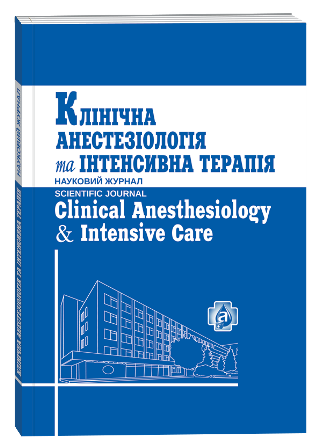THE INFLUENCE OF PROTECTIVE VENTILATION STRATEGY ON THE RATE OF CRITICAL INCIDENTS IN ABDOMINAL SURGERY: THE ROLE OF TOLERANCE TO TRANSIENT HYPOXIA AND HYPERCAPNIA
DOI:
https://doi.org/10.31379/2411.2616.14.2.10Keywords:
protective ventilation, hemodynamic incidents, breath-holding test.Abstract
The aim of the research was to study the effect of the intraoperative ventilation strategy on the rate of critical incidents during major abdominal surgery in patients with different tolerance to transient hypoxia and hypercapnia determined by the duration of the breath-holding test. Methods. The study included 300 patients undergoing major abdominal surgery, all of them were divided into two groups: with a breath-holding duration of 34 seconds or less, (n=150); and a breath-holding duration of more than 34 seconds (n=150). In both groups, patients were randomized into three subgroups: PEEP 5 cm H2O, PEEP 10 cm H2O, and PEEP 10 cm H2O with recruitment maneuver (RM). We evaluated the frequency of critical incidents, oxygenation and the respiratory mechanics g. Results. The rate of hemodynamic incidents was higher in the group with a breathholding duration of 34 seconds or less in all subgroups. The use of RM significantly increased their number compared to PEEP 10 cm H2O. There were no significant differences in the rate of hemodynamic incidents between ventilation strategies in the group of patients with a breath-holding duration of more than 34 seconds. Conclusion. In patients with low tolerance to transient hypoxia and hypercapnia (the duration of the breath-holding test is 34 seconds or less), the use of the lung opening maneuver is associated with the risk of hemodynamic incidents.
References
Ball, L. Intraoperative mechanical ventilation: state of the art / L. Ball // Minerva anestesiologica. – 2017. – Vol.83 (10). – P.1075-88
Fernández-Pérez, E.R. et al. Intraoperative ventilator settings and acute lung injury after elective surgery: A nested case control study / E.R. Fernández-Pérez [et al.] // Thorax. – 2009. – Vol.64. – P.121–7
Hemmes, S.N., Serpa Neto, A., Schultz, M.J. Intraoperative ventilatory strategies to prevent postoperative pulmonary complications: A meta-analysis / S.N. Hemmes, A. Serpa Neto, M.J. Schultz // Curr Opin Anaesthesiol. – 2013. – Vol.26. – P.126–33
Protective lung ventilation in operating room: A systematic review / E. Futier, J.M. Constantin, S. Jaber // Minerva Anestesiol. – 2014. – Vol.80. – P.726–35
Gajic, O. et al. Early identification of patients at risk of acute lung injury: Evaluation of lung injury prediction score in a multicenter cohort study / O. Gajic [et al.] // Am J Respir Crit Care Med. – 2011. – Vol.183. – P.462–70
Jaber, S. et al. A multicentre observational study of intra-operative ventilatory management during general anaesthesia: tidal volumes and relation to body weight / S. Jaber [et al.] // Anaesthesia. – 2012. – Vol.67. – P.999–100
LAS VEGAS investigators. Epidemiology, practice of ventilation and outcome for patients at increased risk of postoperative pulmonary complications: LAS VEGAS – an observational study in 29 countries / LAS VEGAS investigators // Eur J Anaesthesiol. – 2017. – Vol.34 (8). – P.492- 507.
Lovas, A., Szakmány, T. Haemodynamic Effects of Lung Recruitment Manoeuvres / A. Lovas, T. Szakmány // Biomed Res Int. – 2015.
Tusman, G. Noninvasive monitoring of lung recruitment maneuvers in morbidly obese patients: the role of pulse oximetry and volumetric capnography / G. Tusman // Anesth Analg. – 2014. – Vol.118 (1). – P.137-44
Valipour, A. et al. Heart rate variability and spontaneous baroreflex sequences in supine healthy volunteers subjected to nasal positive airway pressure / A. Valipour [et al.] // J Appl Physiol. – 2005. – Vol.99 (6). – P.2137-43.
Satoh, D. et al. Impact of changes of positive end-expiratory pressure on functional residual capacity at low tidal volume ventilation during general anesthesia / D. Satoh [et al.] // J Anesth. – 2012. – Vol.26 (5). – P.664-9.
Возможность прогноза развития критических инцидентов при плановых оперативных вмешательствах в абдоминальной хирургии / К.А. Цыганков и т.д. // Вестник интенсивной терапии. – 2016. – №2. – С.80–84
Сравнение различных методик проведения рекрутмент-маневра у пациентов с различной реактивностью сердечно-сосудистой и дыхательной систем / Р.В. Вейлер // Вестник интенсивной терапии. – 2016. – №5 (S1). – С.4-7.
Comparison of two ventilatory strategies in elderly patients undergoing major abdominal surgery / T.N. Weingarten et al. // Br J Anaesth. – 2010. – Vol.104 (1). – P.16-22.
Заболотских И.Б., Горобец Е.С., Григорьев Е.В., Козлов И.А. и соавт. Периоперационное ведение гериатрических пациентов. Проект клинических рекомендаций ФАР / И.Б. Заболотских и др. // Вестник интенсивной терапии. – 2018. – №1. – С.60–74.
Blevins, S.S., Connolly, M.J., Carlson, D.E. Baroreceptor mediated compensation for hemodynamic effects of positive end-expiratory pressure / S.S. Blevins, M.J. Connolly, D.E. Carlson // J Appl Physiol. – 1999. – Vol.86. – P.285–293.







